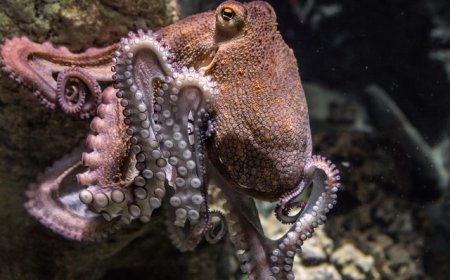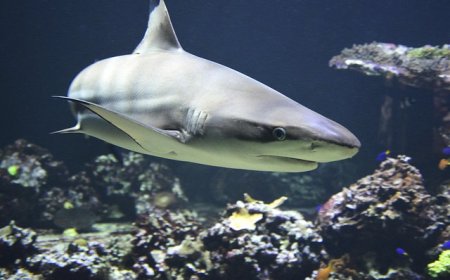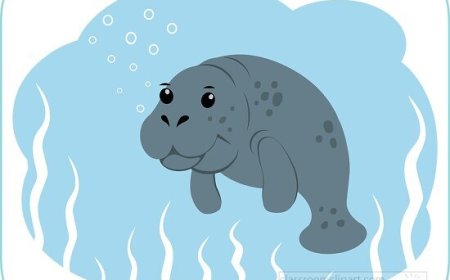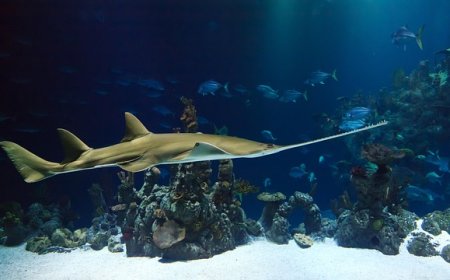Hammerhead Shark Facts for Kids
Discover hammerhead sharks for kids. Learn about their unique head shape, hunting skills, and fascinating ocean facts.
🦈 Hammerhead Sharks: Flat-Headed Hunters of the Sea
Hammerhead sharks are one of the strangest-looking sharks in the ocean. Their wide, flat heads give them amazing hunting superpowers. They are fast swimmers and smart predators.
There are nine species of hammerhead sharks. The most well-known is the great hammerhead (Sphyrna mokarran). Their hammer-shaped head is called a cephalofoil.
🌍 Habitat and Geographic Range
Hammerheads live in warm, tropical and temperate waters worldwide. They are found along coastlines and continental shelves, near coral reefs, bays, and estuaries, and in the open ocean close to shore.
Common areas include Florida and the Caribbean, Hawaii, West Africa, Australia, and Costa Rica and the Galápagos Islands.
They often migrate long distances in groups. They are most active at dawn and dusk.
🦷 The Hammerhead: What’s with the Head?
The shark’s unique head helps it hunt, navigate, and survive. The cephalofoil gives:
- Better eyesight: nearly 360-degree vision
- Stronger smell: more space for sensory organs
- Powerful electroreception: packed with ampullae of Lorenzini
- Steering and balance: the head acts like a wing
This adaptation helps hammerheads hunt stingrays and other hidden prey.
🐟 Diet and Hunting Behavior
Hammerheads are carnivores. They eat stingrays and skates, squid and octopus, bony fish, smaller sharks, and sometimes crustaceans.
They often hunt close to the sea floor, using their wide heads to pin prey. Their sensors detect movement under sand.
They usually hunt alone. They may form schools of up to 100 during migration.
🦴 Physical Features and Adaptations
Hammerhead sizes vary by species:
- Great hammerhead: up to 20 feet
- Scalloped hammerhead: 10–13 feet
- Bonnethead: 3–5 feet
They have a streamlined body, cephalofoil head, countershading, sharp serrated teeth, and a cartilage skeleton. They also have large brains.
👥 Social Behavior and Life Cycle
Hammerheads are social. They form large schools by day and hunt alone at night.
They are viviparous. After 9–12 months of pregnancy, females give birth to 10–50 pups. Pups are born fully developed and swim away immediately.
Juveniles live in nursery areas for safety. Hammerheads can live over 30 years.
⚠️ Threats and Conservation
Hammerheads face serious threats. Many species are endangered or critically endangered.
- Shark finning
- Overfishing and bycatch
- Habitat destruction
- Pollution
- Climate change
Conservation includes international laws, finning bans, protected areas, tagging, and education. Some populations are slowly recovering.
🎉 Fun Facts About Hammerhead Sharks
- 360-degree vision
- Giant schools of over 100
- Bonnetheads eat seagrass
- Heads act like metal detectors
- “Head slap” rays before eating
🧠 Vocabulary List
- Carnivore – an animal that eats other animals
- Cephalofoil – the shark’s wide head
- Countershading – camouflage coloring
- Ampullae of Lorenzini – electroreceptors
- Viviparous – giving birth to live young
- Bycatch – accidentally caught animals
- Cartilage – flexible skeleton tissue
- Migration – long-distance travel
- Nursery area – safe zone for young
- Finning – removing and discarding fins
✅ Hammerhead Shark Quiz: How Sharp Are You?
1. What is special about a hammerhead shark’s head?
A. It’s like a hammer with sensors
B. It’s extra soft
C. It’s covered in fins
D. It has spikes
Answer: A. It’s like a hammer with sensors
2. What do hammerheads mostly eat?
A. Coral
B. Plankton
C. Stingrays and fish
D. Seaweed
Answer: C. Stingrays and fish
3. What does “viviparous” mean?
A. Lays eggs
B. Gives birth to live young
C. Can fly
D. Changes colors
Answer: B. Gives birth to live young
4. Why are hammerheads in danger?
A. They eat too much
B. They are hunted for fins and caught in nets
C. They swim too slowly
D. They live on land
Answer: B. They are hunted for fins and caught in nets
5. What helps hammerheads find food in the sand?
A. Their tail
B. Their dorsal fin
C. Their electro-sensing head
D. Their nose
Answer: C. Their electro-sensing head
🧒 Kid-Friendly Summary
Hammerhead sharks have hammer-shaped heads. They see all around, find hidden fish, and turn quickly.
They live in warm oceans, eat stingrays, and swim alone or in schools. People hunt them for fins and harm their homes. Scientists work to protect them.





















































